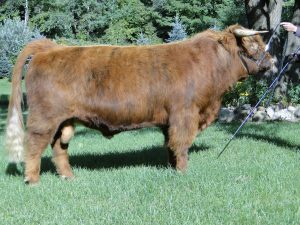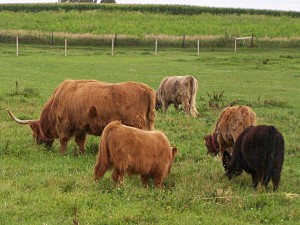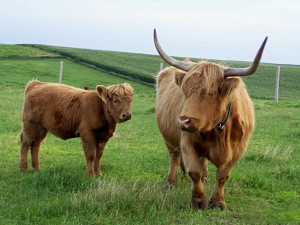
Highland cattle are the oldest registered breed of cattle with a Herd Book being published in 1885. The Scottish Highland Cattle Society was formed in 1884 and most of the cattle registered were black. Originally, there were two subgroups of Highland cattle, which today are merged into one. The smaller, mostly black or brindled cattle were raised on the western islands and were known as Kyloes, and the larger red animals of the Scottish mainland. Today, Highland cattle may be red, black yellow, white, brindle, silver or dun in color. All these colors are recognized by the registry, but only solid colored animals are allowed to be shown in the sanctioned shows. [Click here for a pdf]
Archeological evidence of the Highland breed goes back to the 6th century with written records existing from the 12th century. The first recorded importation into the United States occurred in the late 1890’s when western cattlemen recognized the need to improve the hardiness of their cattle herds. Earlier importations are likely to have occurred since large numbers of Scotch/Irish immigrants came to this country early on, but the absence of a registry precludes any definitive proof. The American Highland Cattle Association registry was formed in 1948. The reasons these ranchers selected Highland Cattle are the same reasons you should also consider the breed.
 Highland Breed Characteristics include:
Highland Breed Characteristics include:
 Calves are small, 40-60 pounds and birthing assists are rare. They produce rich milk allowing for their calf’s steady weight gain. Cows may produce into their late teens reducing the need for frequent herd replacements.
Calves are small, 40-60 pounds and birthing assists are rare. They produce rich milk allowing for their calf’s steady weight gain. Cows may produce into their late teens reducing the need for frequent herd replacements.
Highlands are slow maturing which make the meat fine textured and succulent. In a recent study at Manyberries Research Station, Canada, groups of Hereford, Highland and Highland Herefords crossed were tested. The Highland groups produced 2,000 pounds more beef than the purebred Herefords, while the Highland/Hereford crosses produced 6,000 pounds more than the pure Hereford groups.
Highland cows will average 900-1200 pounds when mature. Bulls will average from 1500-2000 pounds depending on forage conditions. A study by the Scottish Agricultural College determined that Highland beef is significantly lower in fat and cholesterol and higher in protein and iron than other beef breeds.
The British Royal family maintains a fold of Highland Cattle at Balmorals Castle. They are considered royal beef of choice. Highland Cattle gives the rare opportunity for commoners to eat like the royal family. Highland Cattle Societies are found in Great Britain (Scotland), United States, Canada, Australia and several European Countries. The animals are referred to as Scottish Highland Cattle, Scotch Highland Cattle, Highland Cattle or Highlanders. Regardless of where they are located today, Highland cattle can trace their ancestry to Scotland. Importations of Scottish stock and semen in the U.S. and Canada have served to assure continuation of the Highland gene pool.
Highland cattle provide the opportunity to produce a premium quality beef with less cost and effort. They fit into a variety of operations from small farm to commercial beef operations.
They are a true multi-purpose animal, producing meat, milk and fiber. Highlands can be used as oxen or for clearing land of unwanted brush. Many people just enjoy seeing and experiencing these beautiful animals in their pastures. Highland Cattle have a rich history and those working in the Highland breed today see an exciting future ahead. Highland Cattle are a dynamic part of our history and will play an important part in the future in the grass fed cattle industry.